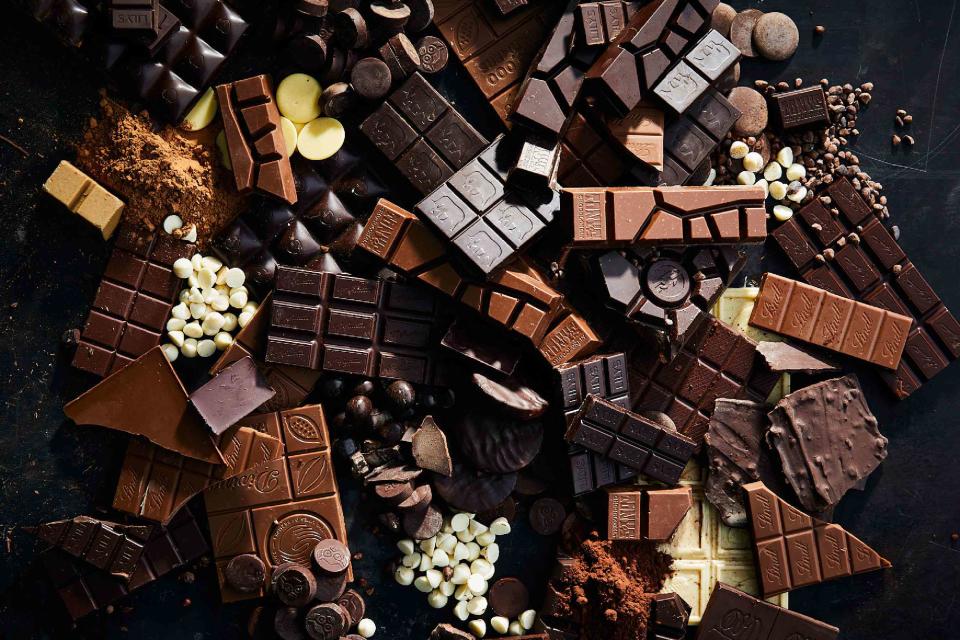When to Use Chocolate Chips, Baking Chocolate, or Cocoa Powder
Here's how to pick the right type of chocolate for cooking and baking.

Christopher Testani / Food Styling by Margaret Monroe Dickey / Prop Styling by Christine Keely
Save finely made bars of chocolate encased in foil and other fancy wrappings for nibbling — their higher ratio of cocoa solids to cocoa butter delivers nuanced flavor that risks being wiped out by other ingredients, as well as lower meltability. For baking and other cooking with chocolate, look to the styles listed here, which provide robust flavor and enough cocoa butter to melt into whatever you’re cooking them with. And if your local store doesn’t carry exactly what you’re looking for, remember, chocolate is also forgiving: You can swap chips for baking chocolate (and vice versa) if needed. Ultimately, what types of chocolate you choose depends on your preference and what you’re using each for.
Related:20 Mistakes to Avoid When Baking with Chocolate, According to Chefs
Chocolate chips, chunks, and morsels
Formulated at various cacao percentages, chocolate chips, chunks, and morsels are made with relatively low levels of cocoa butter so they hold their charming shape when baked, which is what makes them ideal for chocolate chip cookies; less cocoa butter also means more chocolate flavor. That said, quality chocolate chips (sometimes labeled as “baking chips”) often have a decent amount of cocoa butter, so they should melt well enough for recipes like Toasted Hazelnut-Chocolate Sandwiches, where the smoothness of the melted chocolate isn’t mission-critical, though you may use a baking chocolate, too. In a pinch, you can use chocolate chips for sauces, but a baking chocolate or tasting chocolate bar will melt more smoothly.
F&W Pick: Guittard Extra Dark Chocolate Baking Chips 63% Cacao, $5 for an 11.5-oz. bag, guittard.com
Related:How I Learned to Temper Chocolate Without Losing My Mind
Baking chocolate bars and wafers
What is labeled as “baking chocolate” typically contains more cocoa butter than chocolate chips because the objective is greater meltability. When heated, baking chocolate turns fluid and smooth. Because the cocoa butter adds fat, which cuts cacao’s natural bitterness, baking chocolate often has a mellower flavor than chips. Baking wafers (aka pistoles, callets, or fèves) come as small, flattish pieces of chocolate that don’t require chopping and are easier to measure. For Black and Tan Popcorn (where popcorn is enrobed in white and dark chocolate), use a baking chocolate because you need it to be fluid for coating and enrobing the popped corn. Baking chocolate also works best when you want the chocolate dispersed throughout, such as in Chocolate-Cherry Focaccia and Catalan-Style Shrimp in Chocolate Sauce.
F&W Pick: Valrhona Guanaja 70% Cacao Dark Chocolate Fèves, $14 for an 8.8-oz. bag, valrhona-chocolate.com
White chocolate
Made from only cocoa butter, milk solids (or powder), sugar, and perhaps lecithin and vanilla, white chocolate is simply chocolate that’s devoid of cocoa solids. Cocoa butter is sweet and rich, which explains why excellent white chocolate tastes luxurious. Good white chocolate should be pale yellow (the natural color of cocoa butter). For recipes where the white chocolate is caramelized like this Black and Tan Popcorn, shop for white chocolate in the form of baking bars or wafers, which caramelize beautifully and flow nicely for coating; white baking chips, and white chocolate that lists palm or other oils before the cocoa butter, do not perform well.
F&W Pick: Valrhona Ivoire 35% Cocoa Butter Fèves, $14 for an 8.8-oz. bag, valrhona-chocolate.com
Cocoa powder
Unsweetened cocoa powder is great whenever you want intense flavor or need chocolate as a dry ingredient. You can add sweetener, fat, and other ingredients to fine-tune the outcome. Cocoa powder comes in various gorgeous shades of brown, too. Baking recipes often specify Dutch-process (alkalized) and/or natural (nonalkalized) unsweetened cocoa powder. Alkalized cocoa powder is darker in color and slightly mellower in flavor than its natural kin, which is a bit more bitter and complex. Use either kind for hot chocolate (like this Indulgent Hot Chocolate), spice rubs like the one on these Cocoa-Spiced Steaks with Red Wine-Chocolate Sauce, and for Black and Tan Popcorn.
F&W Pick: Guittard Cocoa Rouge Unsweetened Red Dutch-Process Cocoa Powder, $8 for an 8-oz. can, guittard.com
